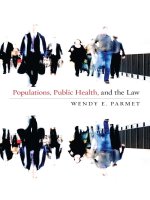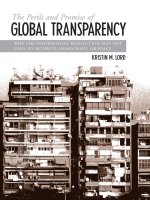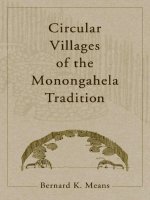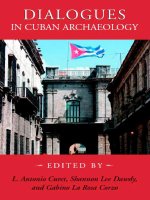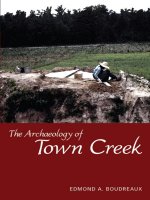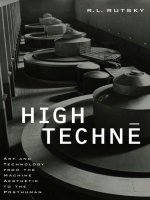university alabama press ancient borinquen archaeology and ethnohistory of native puerto rico oct 2005
Bạn đang xem bản rút gọn của tài liệu. Xem và tải ngay bản đầy đủ của tài liệu tại đây (4.28 MB, 447 trang )
ANCIENT BORINQUEN
Map of the Caribbean Basin.
ANCIENT BORINQUEN
Archaeology and Ethnohistory
of Native Puerto Rico
Edited by Peter E. Siegel
The University of Alabama Press
Tuscaloosa
Copyright © 2005
The University of Alabama Press
Tuscaloosa, Alabama 35487–0380
All rights reserved
Manufactured in the United States of America
Typeface: AGaramond
∞
The paper on which this book is printed meets the minimum requirements of American National
Standard for Information Sciences—Permanence of Paper for Printed Library Materials, ANSI Z39.48–
1984.
Library of Congress Cataloging-in-Publication Data
Ancient Borinquen : archaeology and ethnohistory of native Puerto Rico / edited by Peter E. Siegel.
p. cm.
Includes bibliographical references and index.
ISBN 0-8173-1471-7 (cloth : alk. paper) — ISBN 0-8173-5238-4 (pbk. : alk. paper)
1. Indians of the West Indies—Puerto Rico—Antiquities. 2. Indians of the West Indies—Puerto Rico—
History. 3. Ethnohistory—Puerto Rico. 4. Puerto Rico—Antiquities. I. Siegel, Peter E.
F1969.A53 2005
972.95′01—dc22
2005002033
To Ricardo E. Alegría and Irving Rouse,
Caciques of Puerto Rican Archaeology
CONTENTS
List of Illustrations
ix
Preface
xv
1 The Crab-Shell Dichotomy Revisited: The Lithics Speak Out
Reniel Rodríguez Ramos
1
2 The Paso del Indio Site, Vega Baja, Puerto Rico: A Progress Report
Jeff Walker
55
3 Environmental and Cultural Correlates in the West Indies:
A View from Puerto Rico
Peter E. Siegel, John G. Jones,
Deborah M. Pearsall, and Daniel P. Wagner
88
4 The Status of Paleoethnobiological Research on Puerto Rico
and Adjacent Islands
Susan D. deFrance and Lee A. Newsom
122
5 Ceramic-Age Dietary Patterns in Puerto Rico:
Stable Isotopes and Island Biogeography
Anne V. Stokes
185
6 Deconstructing the Polity: Communities and Social Landscapes of
the Ceramic-Age Peoples of South Central Puerto Rico
Joshua M. Torres
202
7 The Proto-Taíno Monumental Cemís of Caguana:
A Political-Religious “Manifesto”
José R. Oliver
230
8 Rivers of Stone, Rivers within Stone: Rock Art in Ancient Puerto Rico
Peter G. Roe
285
9 The Aftermath of Conquest:
The Indians of Puerto Rico during the Early Sixteenth Century
Karen F. Anderson-Córdova
337
10 Multiple Visions of an Island’s Past and Some Thoughts for
Future Directions in Puerto Rican Prehistory
Peter E. Siegel
353
References Cited
365
Contributors
415
Index
419
viii / Contents
ILLUSTRATIONS
Figures
Frontispiece Map of the Caribbean Basin.
Figure 1.1. General core-®ake lineal reduction model. 20
Figure 1.2. Percentages of ®akes by technique of extraction in the selected
subsample for each lithostratigraphic unit. 25
Figure 1.3. Bipolar cores in the Cuevas component of the site (LU-III). 30
Figure 1.4. Percentages of collapsed raw materials by lithostratigraphic unit in the
®ake products related to core-®ake reduction in the selected subsample. 31
Figure 1.5. Flakes made by the cobble slicing technique. 32
Figure 1.6. Cores made by the cobble slicing technique. 33
Figure 1.7. Chert ®akes made by parallel ®aking. 35
Figure 1.8. Maximum dimension of freehand ®akes in the selected subsample by
lithostratigraphic unit. 36
Figure 1.9. Maximum dimension of ®int freehand ®akes in the selected
subsample. 37
Figure 1.10. Archaic celt (LU-I). 39
Figure 1.11. Cross sections of celts and adzes. 40
Figure 1.12. Necked specimens. 42
Figure 2.1. Locations of excavation units in Pilasters 5 through 8. 59
Figure 2.2. Mechanized and manual excavation of Pilaster 8. 60
Figure 2.3. Post molds, burials, and other features in Pilaster 6. 66
Figure 2.4. Woman, infant, and offering. Death during childbirth. 72
Figure 2.5. Man holding another man’s skull. 73
Figure 3.1. Details of the Manatí, P.R. and Vega Alta, P.R. 7.5-minute
quadrangles. 91
Figure 3.2. Photograph of the pond while Core LM-2 is in process. 92
Figure 3.3. Topographic map of the Maisabel setting. 95
Figure 3.4. Representative soil pro¤les across the Maisabel site. 98
Figure 3.5. Pollen diagram of the Río Cibuco mangrove core. 109
Figure 3.6. Pollen diagram of the LM-2 pond core. 110
Figure 3.7. Phytolith diagram of the LM-2 pond core. 112
Figure 4.1. Map of Puerto Rico showing the locations of sites discussed in
the text. 123
Figure 5.1. General range of isotope values of potential prehistoric food items. 187
Figure 5.2. Source of protein in the diet of individuals from Paso del Indio. 194
Figure 5.3. Whole diet of individuals from Paso del Indio. 194
Figure 5.4. Mean δ
13
C values for human bone collagen and apatite,
Paso del Indio. 195
Figure 5.5. Apatite to collagen spacing from Paso del Indio individuals. 195
Figure 5.6. Source of protein in the diet of individuals from Maisabel. 196
Figure 5.7. Whole diet of individuals from Maisabel. 196
Figure 5.8. Mean δ
13
C values for human bone collagen and apatite, Maisabel. 197
Figure 5.9. Apatite to collagen spacing from Maisabel individuals. 198
Figure 5.10. Temporal change in diet in Puerto Rico. 200
Figure 6.1. Study area. 204
Figure 6.2. Period II site distributions, cost boundaries, and village clusters. 216
Figure 6.3. Period III site distributions, cost boundaries, and village clusters. 217
Figure 6.4. Period IV site distributions, cost boundaries, and village clusters. 218
Figure 6.5. Site type frequencies through time. 221
Figure 6.6. General trends in ceramic distributions through the region. 223
x / Illustrations
Figure 6.7. Territory associated with villages through time. 224
Figure 7.1. Locations of sites with stone-demarcated precincts in Puerto Rico. 232
Figure 7.2. Locations of archaeological sites in the vicinity of Caguana. 233
Figure 7.3. View to the three-pointed karst hills northwest from the oval Plaza C,
Caguana. 234
Figure 7.4. Two perspectives of a three-pointed stone carved from metavolcanic
rock. 235
Figure 7.5. Map of the stone-demarcated precincts of Tibes, Ponce. 239
Figure 7.6. Contour map of Caguana. 240
Figure 7.7. A pair of igneous stone guaízas (masks) from Puerto Rico. 243
Figure 7.8. An incised necklace separator made from Strombus spp. shell from
Site Utu-27. 244
Figure 7.9. A limestone monolith from Site Utu-27. 250
Figure 7.10. The “Duho Oliver,” from Dos Bocas Region, Utuado. 253
Figure 7.11. An anthropomorphic cohoba inhalator from La Cucama
cemetery. 254
Figure 7.12. Oblique aerial photograph of Caguana. 259
Figure 7.13. Close-up plan view of Plaza A and immediate structural features as
mapped by Mason in 1915. 261
Figure 7.14. Petroglyph 24. 262
Figure 7.15. Photo of northern end of Plaza A marking the locations of Petroglyphs
1, 11, and 17–22, and oval Precinct C and its sole petroglyph (23). 262
Figure 7.16. A simple face and a doglike zoomorphic being related to the Domain
of the Nonliving. 265
Figure 7.17. Petroglyph 3. 266
Figure 7.18. Petroglyph 4. 268
Figure 7.19. Ornithomorphic petroglyphs. 269
Figure 7.20. Petroglyphs 9, 10, 11, 12, and 13. 270
Figure 7.21. Petroglyph 17. 273
Figure 7.22. Petroglyph 18. 273
Figure 7.23. Petroglyph 19. 274
Figure 7.24. Petroglyph 21. 275
Illustrations / xi
Figure 7.25. Petroglyph 22. 275
Figure 7.26. A dual and quadripartite structural model of the iconography and
their respective domains. 277
Figure 7.27. A model of the spatial cosmic domains within the central Plaza A,
Caguana. 279
Figure 7.28. An iconic image from Caguana. 281
Figure 8.1. A map of Puerto Rico situating the rock art sites discussed in
the text. 286
Figure 8.2. A close-up of northern ledge pictographs from Chamber 2, Cueva de
Mora, Comerío. 287
Figure 8.3. A ball park petroglyph, Caguana. 288
Figure 8.4. Anatropic imagery in Puerto Rican prehistoric pottery and
rock art. 290
Figure 8.5. A proposed three-phase seriation of Puerto Rican petroglyphs. 292
Figure 8.6. A selection of beach rock petroglyphs from the site of Maisabel
Playa. 293
Figure 8.7. River boulder petroglyphs, Río Caguitas. 294
Figure 8.8. A cave petroglyph of a “wrapped ancestor,” Cueva del Indio 295
Figure 8.9. Group A beach rock petroglyphs from Maisabel Playa. 296
Figure 8.10. Stalagmite petroglyphs from Cueva de la Momia, Comerío. 303
Figure 8.11. The petroglyphic assemblage from the Pueblito Carmen river
boulder. 304
Figure 8.12. A componential approach to the somatic components of anthropo-
morphic petroglyphs in Puerto Rico. 305
Figure 8.13. The beginnings of a generative grammar for Puerto Rican anthropo-
morphic petroglyph design. 306
Figure 8.14. Two versions of an El Bronce crowned anthropomorphic head. 309
Figure 8.15. Cross-media isomorphisms in Chican Ostionoid (Taíno) incised
ceramics and petroglyphs. 311
Figure 8.16. The Cueva la Mora, Comerío, as cosmogram. 312
Figure 8.17. A planimetric map of all 12 chambers of la Mora cavern. 313
Figure 8.18. The peripheral “portal guardian” petroglyphs from Cueva
la Mora. 314
xii / Illustrations
Figure 8.19. The “wrapped ancestor” group from the northern ledge of
Chamber 2, Cueva la Mora. 317
Figure 8.20. A selection of the northern ledge pictographs from Chamber 2,
Cueva la Mora. 318
Figure 8.21. A group of “wrapped ancestors” from Chamber 2, Cueva la Mora. 319
Figure 8.22. The central “shamanic” male ¤gure pictograph from the southern
ceiling, Cueva la Mora. 320
Figure 8.23. A selection of the southern ceiling pictographs, Cueva la Mora. 321
Figure 8.24. The “living dead” and their ancestors. 322
Tabl e s
Table 1.1. Frequency Distribution of Gross Types by Pilaster in the Analyzed
Collection. 14
Table 1.2. Flake Subtypes by Collapsed Raw Materials in the Selected Subsample
of Core-Flake Products for Each of the Lithostratigraphic Units. 15
Table 1.3. Core Types by Collapsed Raw Materials in the Different Lithostrati-
graphic Units of the Selected Subsample. 21
Table 1.4. Flake Type Frequencies by Reduction Protocol and Lithostratigraphic
Unit in the Selected Subsample. 26
Table 2.1. Paso del Indio Site Radiocarbon Dates. 79
Table 3.1. Maisabel Coring Project Radiocarbon Dates. 102
Table 3.2. Sedimentation Rates and Inferred Landscape and Pond Conditions
during Major Cultural Periods. 103
Table 3.3. Documented Prehistoric Sites in the Vicinity of Maisabel. 116
Table 4.1. Sources of Prehistoric Archaeobotanical and Zooarchaeological
Assemblages from Puerto Rico and Vieques. 124
Table 4.2. Archaeobotanical and Zooarchaeological Assemblages from Common-
wealth of Puerto Rico. 128
Table 4.3. Macrophytic Identi¤cations from Archaeological Sites on Puerto Rico
and Vieques. 132
Table 4.4. Ethnobotany of Plant Taxa from Puerto Rican Sites. 138
Table 4.5. Seed and Other Nonwood Plant Remains from Puerto Rico and
Vieques. 142
Illustrations / xiii
Table 4.6. Wood Remains from Ceramic-Age Sites on Puerto Rico and
Vieques. 145
Table 4.7. Zooarchaeological Identi¤cations from Archaeological Sites on Puerto
Rico and Vieques. 151
Table 4.8. Taxa Totals for Zooarchaeological Assemblages from Puerto Rico and
Vieques. 176
Table 5.1. Isotope Data for Human Skeletal Samples from Paso del Indio and
Maisabel in Puerto Rico. 192
Table 6.1. Chronological Model for Prehistoric Puerto Rico. 206
Table 6.2. Site Data. 212
Table 7.1. The Quadripartite Structure of the Cemís of Hispaniola. 252
Table 7.2. Precinct Measurements and Number of Associated Petroglyphs. 260
xiv / Illustrations
PREFACE
A book on the prehistory and ethnohistory of a modern geopolitical entity is
arti¤cial. It is unlikely that prehistoric occupants recognized the same bounda-
ries and responded to the same political forces that operated in the formation
of current nations, states, or cities. Yet archaeologists traditionally have pro-
duced such volumes, and they generally represent anchors for ongoing re-
search in a region for years to come. A book on the prehistory of Puerto Rico
may be especially contrived. How do we separate events and processes that
occurred in the past on Puerto Rico from immediate neighbors, the wider
Caribbean Basin, lowland South America, and, perhaps, Central America?
We don’t. To varying degrees, all of the chapters in this book at least address
issues and in some cases draw on data from beyond the boundaries of Puerto
Rico. As Irving Rouse observed long ago, often the passageways between
islands were the logical units of analysis and loci of intense cultural activity
(Rouse 1951).
The intensity and quality of archaeological research on Puerto Rico has
skyrocketed over the past two decades. Compliance-driven cultural resource
management investigations combined with ongoing academic studies have
resulted in a body of data that may be unique in the Caribbean. Visits to the
archives and site ¤les of the State Historic Preservation Of¤ce and the Insti-
tute of Puerto Rican Culture, both located in San Juan, reveal thousands of
survey and excavation reports and documented archaeological sites. In addi-
tion, graduate students and researchers from Puerto Rico and abroad have
been keeping apace with innovative methods of analysis and theoretical per-
spectives.
Archaeologists actively addressing a broad range of topics were invited to
prepare chapters for this book on the prehistory and ethnohistory of Puerto
Rico. The book is not meant to supplant previous synthetic studies of the
island. Rouse’s two-volume survey will always be a crucial source of informa-
tion (Rouse 1952a, 1952b). However, ideas about what happened in the past
are constantly changing as theoretical frameworks change, methodological
advances are developed, and new data are recognized and acquired.
These three domains of research have been progressing in tandem at a
rapid pace in Puerto Rico. Others and I felt that it was time to take stock
and to evaluate a range of issues and datasets currently positioned at center
stage in the archaeology of the island. Most of the authors invited to contrib-
ute to this volume are known for their long-term involvement in Puerto Rican
archaeology. Others are relatively new to the ¤eld but are actively conducting
cutting-edge research. In total, this book provides a comprehensive overview
of recent trends in the prehistoric archaeology of Puerto Rico. The substance
of the volume offers a combination of new data, synthesis, and new insights
on topics that are of fundamental importance in current Puerto Rican ar-
chaeology. And, issues that are crucial to Puerto Rico both re®ect and illumi-
nate similar concerns elsewhere in the West Indies, lowland South America,
and Central America.
This book concentrates on issues and data of the ceramic age. Although
researchers use different beginning dates for the ceramic age in Puerto Rico,
it is generally agreed to be around 200 b.c. (Rouse 1992; Siegel 1991a). Early
ceramic-age groups began colonizing the Caribbean islands by approximately
400–500 b.c. (Siegel 1991b). These people originated in the Orinoco Valley
of Venezuela. As a group, the colonists are recognized by a distinctive mate-
rial culture tradition, including thin-walled elaborately painted, incised, and
modeled ceramic vessels and ¤gurines and carved and ground shell, bone,
stone, and coral objects (Roe 1989a; Rouse 1992). Similarities in material cul-
ture across sites and through time provide the basis for assigning the groups
to a single series of Saladoid cultures, named after the Saladero type site
excavated by Rouse and Cruxent (1963). A source of considerable debate is
the nature and extent of interactions between the resident Archaic popula-
tions of the West Indies and the Saladoid colonists (Chanlatte Baik 1995;
Siegel 1989a). Further, it has been suggested that some Archaic groups, espe-
cially on Hispaniola, may have developed pottery prior to or in connection
with the arrival of the Saladoid colonists (Rouse 1992:90–92; Veloz Maggiolo
et al. 1974). New information, some of which is explored in this book, indi-
cates that Archaic people may have been managing and modifying the land-
scape more than what was traditionally recognized. Another book will be
xvi / Preface
needed to explore the dynamics and complexity of the Archaic cultures of
Puerto Rico.
The 16 or more centuries of ceramic-age occupations on Puerto Rico re-
veal dramatic shifts in how people related to one another, the environment,
and the cosmos. The earliest Saladoid colonists, referred to as the Haci-
enda Grande complex (ca. 200 b.c.–a.d. 400), occupied large seemingly self-
contained villages dispersed around the periphery of the island in coastal or
near-coastal settings. All evidence indicates that these people were egalitarian
horticulturalists, who brought to the West Indies a conception of the universe
derived from Amazonian cosmology (Alegría 1986b; López-Baralt 1985; Roe
1982, 1997; Siegel 1997; Stevens-Arroyo 1988; Wilbert 1981, 1987). By late
Saladoid times (Cuevas complex, ca. a.d. 400–600/700), groups began occu-
pying mid to upper drainage locations. The trend toward settling the interior
foothills and mountains continued during the post-Saladoid, or Ostionoid,
occupations (Monserrate [ca. a.d. 600/700–900], Santa Elena [a.d. 900–
1200], and Esperanza [a.d. 1200–1500] complexes). By approximately a.d.
700, formally designed ball courts and ceremonial plazas were included in the
repertoire of village or settlement types constructed by the occupants of
Puerto Rico (Alegría 1983; Siegel 1999). The idea for formally recognized
ceremonial spaces was deeply rooted in the early Saladoid period, apparent
in the structural organization of many early ceramic-age sites on Puerto Rico
and the Lesser Antilles (Chanlatte Baik and Narganes Storde 1983; Rainey
1940; Rodríguez López 1991; Rouse 1974; Rouse and Morse 1999; Siegel 1996;
Versteeg 1989).
During the Santa Elena period, there was a signi¤cant increase in the
number and variety of sites documented for Puerto Rico, compared to earlier
periods. This observation has generally been interpreted to be a product of
demographic factors, although recently social and political considerations have
been evaluated (Curet 1992a; Rodríguez López 1990; Siegel 2004). Demo-
graphic, social, and political factors have also been reviewed in the context of
increasingly competitive and territorial chie®y polities, most notably during
the Santa Elena and Esperanza periods (Siegel 2004). Culture change during
the ceramic age of Puerto Rico has been investigated from a range of per-
spectives, broadly subsumed within the realms of subsistence, ecology, social
and political organization, and cosmology. In one way or another, all of these
realms are addressed in the current book.
The chapters in the volume are generally organized by scope of analysis.
Studies of artifacts and individual sites are presented at the beginning and
more general thematic overviews at the end. Reniel Rodríguez opens the book
with his careful analysis of lithic distinctions between early and late ceramic-
Preface / xvii
age groups as represented in the large strati¤ed Paso del Indio site. Rodríguez
addresses the venerable crab-shell “dichotomy” using a line of evidence here-
tofore not considered. Jeff Walker then examines the larger context of Paso
del Indio, reviewing the excavation history and major classes of data collected
from this large intensively occupied late Saladoid and Ostionoid village. A
few kilometers to the north of Paso del Indio, situated on the Atlantic coast,
is the Maisabel site. This site was the center of considerable research during
the 1980s and early 1990s, resulting in numerous publications and theses, one
of which was my dissertation (Siegel 1992). John Jones, Deborah Pearsall,
Daniel Wagner, and I present results of a sediment coring project that we
conducted in the environs of Maisabel and offer suggestions into Late Ar-
chaic and ceramic-age land-use history and cultivation practices. Susan de-
France and Lee Newsom provide an island-wide summary of subsistence re-
search, from the respective disciplines of zooarchaeology and archaeobotany.
Anne Stokes addresses dietary patterns during the ceramic age by examining
carbon and nitrogen isotope ratios in a series of human skeletons. Her study
was performed within the framework of biogeography and thus she evaluates
skeletal remains from other sections of the Caribbean in addition to Puerto
Rico.
Joshua Torres reviews changes in the social landscape of south-central
Puerto Rico. Combining data generated from compliance-mandated investi-
gations with academic research Torres traces settlement patterns from the
early to late ceramic periods and constructs models of political and social
organization for this region. José Oliver addresses political and ideological
organization using settlement and iconographic data in Caguana and the sur-
rounding landscape. Peter Roe reviews the current state of rock art studies on
the island. Rock art is a particularly dif¤cult medium to address beyond sim-
ple description. Roe presents a good balance between tight description and
interpretation, offering an example of how explanatory research may proceed
using rock art. Karen Anderson closes the book in her discussion of Taíno life
during the century following Spanish colonization, thus marking the end of
prehistory in Puerto Rico.
The title of the book, Ancient Borinquen, acknowledges the indigenous
name for Puerto Rico. When the Spanish arrived, they observed that the
Native American occupants called the island Borinquen (variously Boriquén,
Boriquen, Buriquén, Borinquén, Burenquén) (Arrom 2000:131–145). Many
of the early Spanish accounts refer to the Native Americans of Puerto Rico
as borinqueños. Today, residents of the island frequently refer to Borinquen to
evoke a link with the past and to assert a sense of independent identity.
This book came to fruition because of the hard work and support of many
xviii / Preface
people and institutions. John Milner Associates provided infrastructural sup-
port and Margy Schoettle helped in matters of formatting. I thank the
authors for sending me their chapters, working through various rewrites, and
responding to numerous requests, comments, and questions. Finally, Rosa,
Diana, and David put up with a lot during the process, when I spent many
long evenings and weekends at the of¤ce and carried my laptop to piano and
violin lessons, the dentist, and shopping.
Preface / xix
ANCIENT BORINQUEN
1
The Crab-Shell Dichotomy Revisited
The Lithics Speak Out
Reniel Rodríguez Ramos
In the early 1930s, Froelich Rainey was sponsored to pursue excavations in
Puerto Rico as part of the Caribbean Archaeology Program of the Peabody
Museum of Yale University. As stated by the program director, Cornelius
Osgood (1942:6–7), these excavations were made in an “attempt to improve
the methodology of archaeology through intensive research in a particular
area, as well as to resolve the Historic problems of the aboriginal populations
of the West Indies.” Following these objectives, Rainey conducted ¤eldwork
at eight sites in Puerto Rico, along the coast and in the mountainous interior.
As a result of this work, Rainey indicated that there was a generalized dis-
ruption in the cultural sequence of Puerto Rico; he consistently observed the
presence of a layer dominated by crab claws in midden deposits, thus named
the Crab culture, overlaid by a cultural stratum that evidenced the intensive
exploitation of shells and other marine dietary elements, which he termed the
Shell culture. He also noted that the ceramics belonging to the Crab culture
were well ¤red, had hard paste, and their surfaces were painted. In contrast,
pottery from the Shell culture was unpainted and coarse-tempered. Rainey
concluded that these two cultures re®ected two different migrations from
South America. Furthermore, even though by that date there had not yet
been any formal discovery of a preceramic component in Puerto Rico, he
indicated that “The recent excavations have had no bearing on this Ciboney
culture except to show that some of the traits by which it is characterized
according to Harrington are found in the late, Shell Culture, deposits in Porto
Rico” (Rainey 1940:180). The existence of these two cultures, which among
other things presented contrasting protein bases, gave rise to the highly dis-
cussed crab-shell dichotomy.
A couple of years later, Irving Rouse arrived in Puerto Rico to continue
the work initiated by Rainey as part of the Scienti¤c Survey of Puerto Rico
and the Virgin Islands. Rouse’s (1940:49) initial impression of West Indian
ceramics, based primarily on his typological analysis of materials from Puerto
Rico and Haiti available at the Peabody Museum, was “that pottery-making
in the West Indies had a multiple origin, from both North and South America,
rather than a single origin from the latter continent.” However, a decade later
in his extensive publication of the results of his work on the island he pre-
sented a markedly different perspective (Rouse 1952a, 1952b). Based on the
latter studies, Rouse concluded that there was a “continuum of ceramic
modes” between the Crab and Shell culture pottery, suggesting that there was
only one migration of pottery makers to the Antilles. Since then, Rouse’s
model has become the most widely used chrono-cultural framework in Ca-
ribbean archaeology. In the latest version of his model, Rouse (1992) indi-
cated that there were two migrations to Puerto Rico: the Archaic peoples
followed by the Saladoids. The Saladoids were divided into two subseries, the
Huecan and the Cedrosan Saladoid; the Archaics as well as the Huecan
Saladoid were quickly absorbed or pushed west to the Greater Antilles by the
earliest Cedrosans (represented by the Hacienda Grande ceramic style), who
then evolved in Puerto Rico into the Ostionoid series; this series presented
two major subseries on the eastern and western halves of the island (Elenan
and the Ostionan Ostionoid, respectively), which eventually developed into
the Chican Ostionoid, the subseries that represents the remains of the Taínos.
There seems to be general agreement on two points: that Archaic cultures
“contributed little to the subsequent peoples and cultures of the Greater An-
tilles” (Rouse and Alegría 1990:80) and that the Cedrosan Saladoid peoples
represent the “ancestors of the Tainos” (e.g., Rouse 1992:37, 49). During the
last three decades, with the upsurge of processual concerns concomitant with
the generalized decrease in emphasis on chronology building, studies dealing
with the ceramic age in Puerto Rico such as those on settlement patterns
(Curet 1992a, 1992b; Torres 2001), sociopolitical organization (Curet 1992a;
López 1975; Siegel 1992), religious development (Curet and Oliver 1998;
Rouse 1982; Walker 1993), and dietary shifts (deFrance 1989; Keegan 1989a;
Stokes 1998), among others, have commonly presumed the presence of a sin-
gle cultural series operating on the island at any point in time. Following this
argument, it has been proposed that intra-societal dynamics of Cedrosan
populations led to increasing social complexity and shifts in material culture,
resulting in the Ostionoid series and eventually culminating in the develop-
2 / Reniel Rodríguez Ramos


